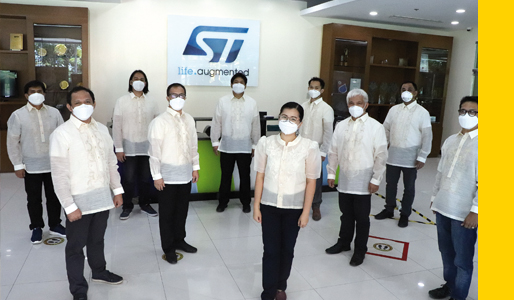Health and Safety
Health & Safety
Our Ambition
Be a safe workplace with zero injuries, zero occupational diseases and ensure healthy lives and well-being for all.
2025 GOAL
<0.15%
recordable cases (RC)*for employees and contractors
* injuries and illnesses
RC for contractors will be available next year.
We are committed to protecting the health and safety of employees and subcontractors by providing a safe working environment, preventing work injuries and illnesses, and providing access to healthcare. We were even more vigilant in 2020. Since the beginning of the COVID-19 pandemic, ST has had two priorities:
- the protection and safety of our employees and our subcontractors by maximizing all preventive measures that can be put in place
- the continuity of our activities to fulfill our commitments
Despite the challenges we have faced around the world, we have shown great resilience, whether to strengthen our culture of health and safety alongside our employees, or to promote well-being everywhere and for everyone and ensure the continuity of our business and the performance of our Company. I 103-1 I
Health
COVID-19: proactive health risk management
Proactive
measures to protect our employees
At the beginning of 2020, before the pandemic was officially declared by the World Health Organization, we activated a Corporate Crisis Team (CCT) to implement immediate measures to protect our employees, ensure the continuity of our operations, and limit the spread of the virus at our sites. As the virus began to spread globally, we set up regional and local crisis teams to adapt to local regulations and needs, and rapidly deployed the following measures across all our sites:
- regular and specific communication to all ST employees according to the alert levels of each site
- strict control of site entrances with a self-declaration and filtering process
- distribution of personal protective equipment: masks with clear instructions on how and when to wear, temperature checks and hand sanitizer everywhere and for all
- social distancing: protective measures in canteens, flow management in staircases, lifts and corridors, strict minimum distance to be respected everywhere and restrictions on the use of meeting and training rooms
- working from home for eligible employees (more than 15,000 employees worldwide) with a dedicated home office intranet page and 24/7 psychological support (see Focus)
- adapted measures to minimize potential COVID-19 transmission in some areas, such as cafeterias or air conditioning systems
- planning for ‘back to normal’ progressive measures driven by site managers and adaptable to the health situation of each country (planning was developed according to applicable regulations, including trade union agreements and site hosting capacity)
Focus
24/7 Psychological support for employees
Employee well-being is a key focus at ST and promoting high-quality working conditions was even more important in 2020. At the onset of the global health crisis, we partnered with Eutelmed to provide all employees and their families around the world with 24/7 access to a dedicated, confidential support platform, including an online network of over 100 clinical psychologists, to provide psychological support and advice in coping with the pandemic. With more than 5,000 connections from ST employees and their families in 2020, Eutelmed organized awareness sessions on subjects such as stress, quality of sleep and anxiety, as well as online self-assessments to evaluate employees’ feelings and moods. They also provided an assistance hotline and dedicated services such as training for managers or coaching to help them manage the constraints of working remotely.
Thinking beyond the pandemic, in December 2020 we extended the Eutelmed platform into a full employee assistance program named ‘STCare’, giving all our employees permanent access to immediate, anonymous and confidential care, 24/7. We believe that supporting our people and their families in any worrying or stressful situation is essential. STCare, with the support of Eutelmed, gives all ST employees a helping hand whenever they feel that difficulties at work or at home are affecting their well-being.
Our Calamba site (the Philippines) implemented specific measures and amenities: protective barriers in the canteen, food sanitary protocols, touchless thermal scanning, COVID-19 safety communication to employees’ family members, and a campsite for volunteer employees who chose to stay 24/7 on site during the peak of the pandemic, when authorities restricted local movement (see quote).

Elvira Oclarino
Technician Specialist, Assembly Process Control, Calamba (the Philippines)
As one of the campers at ST Calamba (the Philippines), I believe the effort and the generosity of the Company was commendable in meeting the needs of volunteers and providing a comfortable, safe and convenient workplace during their stay inside the plant. As well as implementing stringent measures to protect employees against COVID-19, ST provided tents, hygiene kits, mattresses, bed linen, shower rooms, free wi-fi, free meals and a free laundry service. In addition, ST provided transportation for the other workers who were still able to commute. It was a truly safe and comfortable workplace.”
We also communicated these health and safety practices and risk management measures to the European Semiconductor Industry Association (ESIA), to share our practices with other members (see Our approach to the environment).
Thanks to all the measures taken, all ST manufacturing sites were operational in 2020, while also ensuring the safety of employees on site. I 103-2 I
Safety
0.14
recordable injury case rate
In 2020, we further improved our recordable case rate (injuries) reaching 0.14 (down 11% vs 2019) better than our target of 0.16. However, our severity rate increased due to several prolongations that accounted for 60% of days lost. 40% of these prolongation days concerned falls or slips.
Recordable cases rate – injuries(1)
I 403-9 I
Recordable cases rate – injuries and illnesses(1) I 403-9 I 403-10 I
Severity rate(1)
We continue to align our safety programs with industry risks, with a priority on preventing employees’ potential exposure to hazards such as chemicals (see Chemicals), fire, radiation and nanomaterials; and mechanical, handling and ergonomic risks.
Due to COVID-19 restrictions, we organized fewer field safety visits by managers (28,400 visits vs 31,400 in 2019) but we maintained our focus on safe behaviors and on preventing unsafe acts and conditions, in line with SDG target 8.8 on the promotion of a safe and secure working environment for employees.
For example, our Ang Mo Kio site (Singapore) published a video showing the right behaviors to adopt when moving from one place to another, when and where to use (or not) mobile devices, and the correct use of the handrail when using stairs. They also communicated about wearing proper footwear to prevent falls or slips and used visual aids such as posters to remind people about the golden rules of safety.
At our Crolles site (France), undertaking multiple building and retrofit projects in a short timeframe meant safety was vital. To ensure a safe and secure working environment, a dedicated working group was established to develop a robust management process. This included a safety prevention approach, training support and immediate actions to correct possible safety discrepancies.
Our Rousset site (France) created a ‘Safety First’ escape game for new employees, which involved finding hazards in an unsafe environment within a limited time.
Subcontractors
0.24
subcontractor Lost Workday Case incidence rate
The Lost Workday Case (LWDC) incident rate for subcontractors was on target in 2020, reaching 0.24.
In 2021, we will report all recordable injury cases and occupational diseases for our on-site subcontractors. We updated our internal reporting tool, ‘Safetrack’, to enable us to do this effectively. Thanks to this new functionality, we can better monitor our progress towards our 2025 safety target for both employees and subcontractors. I 103-3 I
|
2016 |
2017(1) |
2018 |
2019 |
2020 |
||
|---|---|---|---|---|---|---|---|
Lost workdays cases per |
0.35 |
0.24 |
0.29 |
0.26 |
0.24 |
||
|
|||||||
Contributing to the Sustainable Development Goals
Our commitments and programs as described above contribute to:
SDG target 3.8 – Achieve universal health coverage, including access to quality essential healthcare services and access to safe, effective, quality, and affordable essential medicines and vaccines for all.
SDG target 8.8 – Protect labor rights and promote safe and secure working environments for all workers.
2020 OBJECTIVES |
Status |
Comments |
|
Employee severity rate ≤2.0. |
|
3.1 |
|
|
Subcontractors Lost Workday Case rate (LWDC) ≤0.24. |
|
0.24 |
|
Recordable case rate (injuries) for employees ≤0.16. |
|
0.14 |


